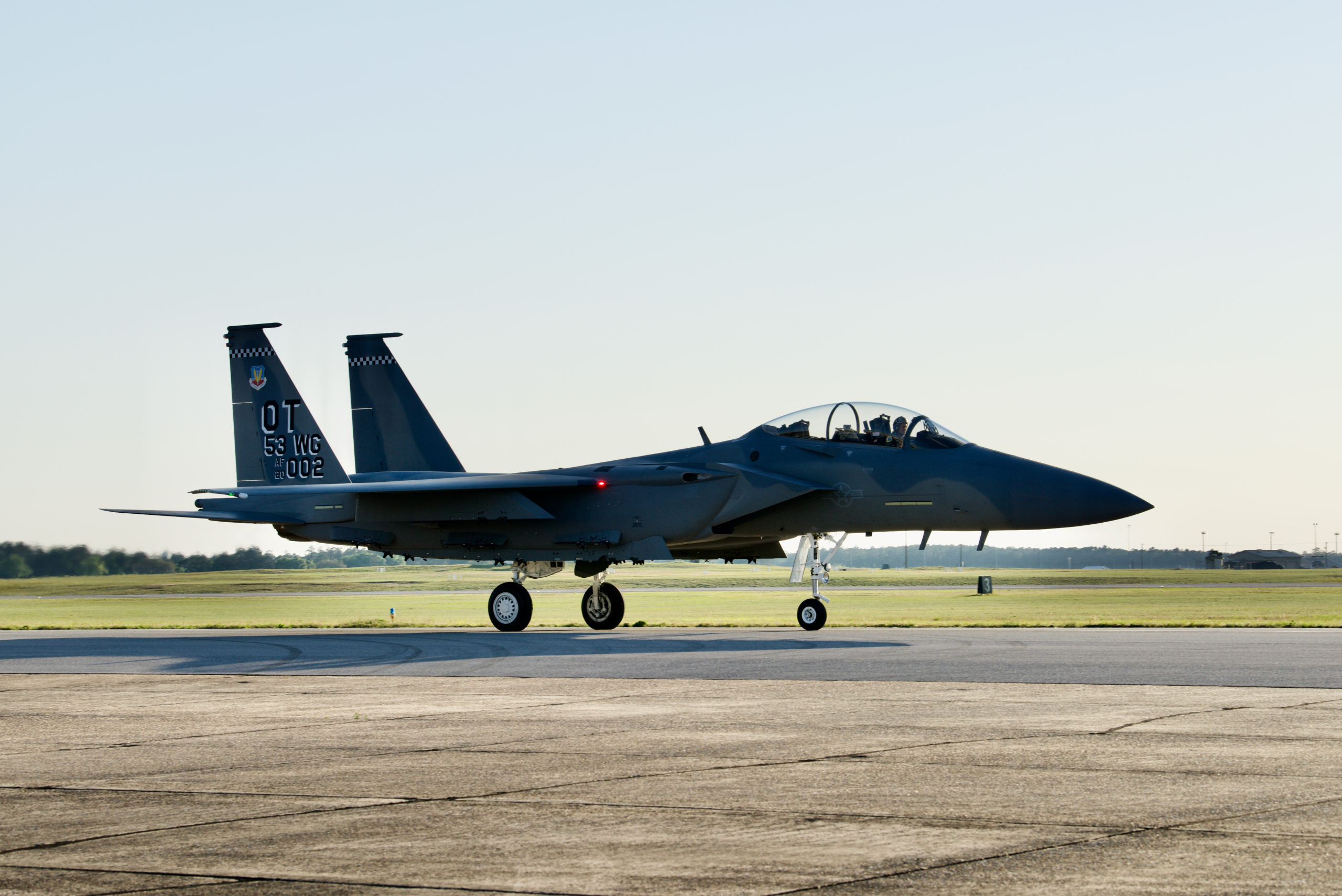
We Talk F-15EX’s New Radar With The Woman Who Runs The Program Behind It
The most capable F-15 Eagle ever built also sports what is arguably the world's most powerful fighter radar.
BY TYLER ROGOWAY APRIL 19, 2021The Air Force's induction of the F-15EX into its ranks has made a lot of buzz as of late. It's amazing just how fast the aircraft and the acquisition initiative that supported it became a reality. Just over two and a half years after The War Zone broke the story on the concept's existence, the first jet wearing USAF markings landed at Eglin AFB in Florida and got named the Eagle II.
The aircraft has an array of new features, which you can read all about, as well as what it is like to fly an Advanced Eagle here, but at the heart of the F-15EX is its powerful AN/APG-82 Active Electronically Scanned Array (AESA) radar. Far more sensitive, reliable, and farther reaching than its mechanically scanned forebear, the APG-82 is this new Eagle's 'eyes.' It is also being retrofitted into existing F-15E Strike Eagles in the USAF's stable.
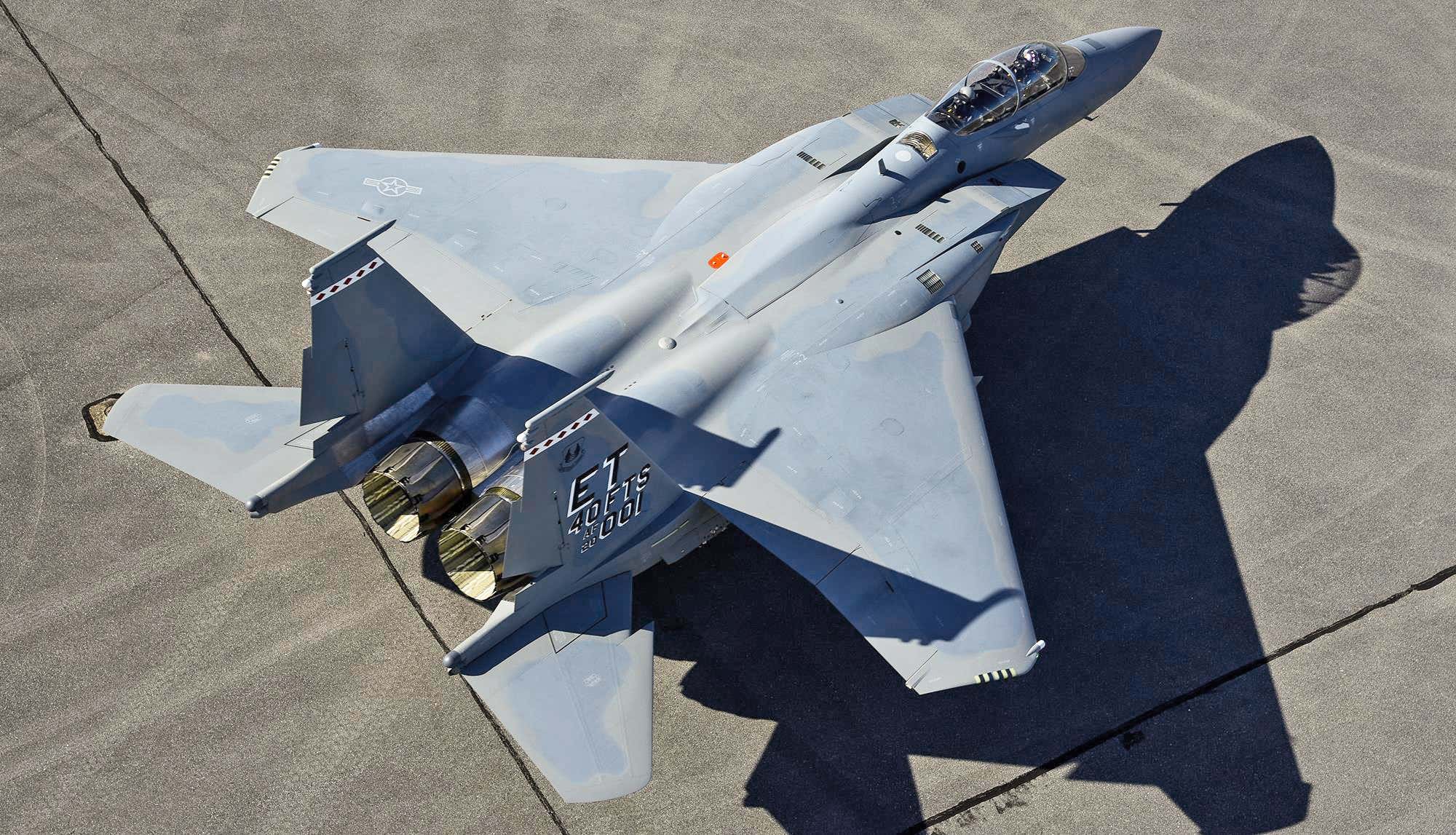
USAF
F-15EX.
With all this in mind, The War Zone talked in-depth with the head of Raytheon's F-15 radar program, Michelle Styczynski, who has been on the Eagle program with the company for two decades.
Here is that interview:
MS: Just a little bit of background about our F-15 radar programs—they are really within the secure sensor solutions product line. We are within that product line. We do follow the radar, multiple radars, all F-15 derivative, through their lifecycles—development, production, sustainment.
We also do have a lot of international work coming in, we have some programs already in-house that we're working... So we're really excited about what we can bring internationally with APG-82.
I have been in this role for the last year and a couple of months, so I am really excited to be part of this program. I have actually been a part of the F-15 program since I started my career at Raytheon about 18 years ago. So I have a lot of history on the program, and this essentially is the dream job for me… I’ve been really lucky to be super supported by my leadership to take the helm of this area and continue to grow it with our USAF, Boeing, and international partners. So I'm really blessed to be here. I have a lot of passion for the product, but it really comes from my years of experience on F-15 radar and obviously, the wonderful people that I get to work with every single day.
Tyler: What does the APG-82 radar bring to the Strike Eagle and its derivatives, like the F-15EX, that the APG-70 does not?
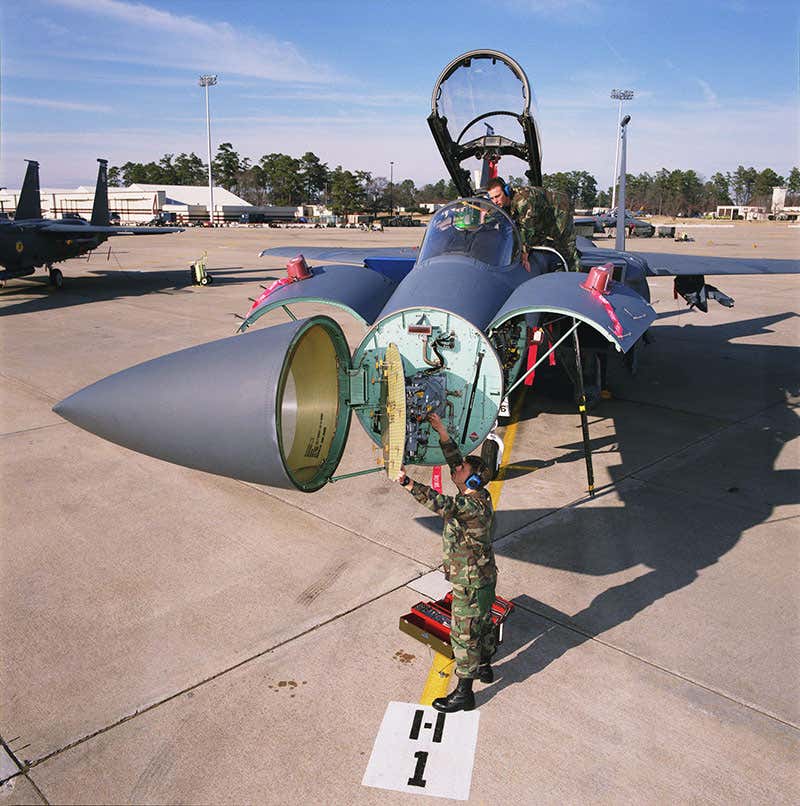
RAYTHEON
The AN/APG-70 multi-mode pulse-Doppler radar is mechanically scanned and was the radar delivered with the F-15E Strike Eagle in the late 1980s. It was remarkably advanced for its time and it has been progressively upgraded over the years and installed on many foreign F-15 Strike Eagle derivates, as well as the F-15E. But now, the AN/APG-82 Active Electronically Scanned Array (AESA) radar is being installed on new-build Eagles and is being offered for retrofit. The USAF's F-15Es are receiving the type as part of their mid-life upgrade.
LM: I think the APG-82 provides a number of tactical advantages that include increased standoff from air-to-air and surface-to-air threats. It also brings greater search coverage, speed of processing targets, and then reduced aircrew workload.
Additionally, compared to the APG-70, the APG-82 also provides increased reliability and supportability, which directly correlates to aircraft availability. With the MSA [the previous Mechanically Scanned Array on the Strike Eagle and foreign derivatives, the APG-70], obviously, there was a lot of care that needed to be applied there, and in this situation, you don't really have that based upon the mechanics of the system.
Tyler: A lot less moving parts, correct?
MS: Yes, lots less moving parts and so the APG-82 brings better reliability compared to the APG-70. So that definitely helps from a maintainability and sustainability perspective.
Tyler: We hear a lot about Active Electronically Scanned Array (AESA) radar technology these days and the capabilities that it provides. Are there any areas where the mechanically scanned array still has an advantage over the AESA? If so, what are the trade-offs there?
MS: Yeah, I think in my mind right now, the AESA is really where it's at. I point back to the comments that the chief pilot made on the F-15EX’s first flight—the APG-82 is the most powerful radar and there's nothing that really compares to it.
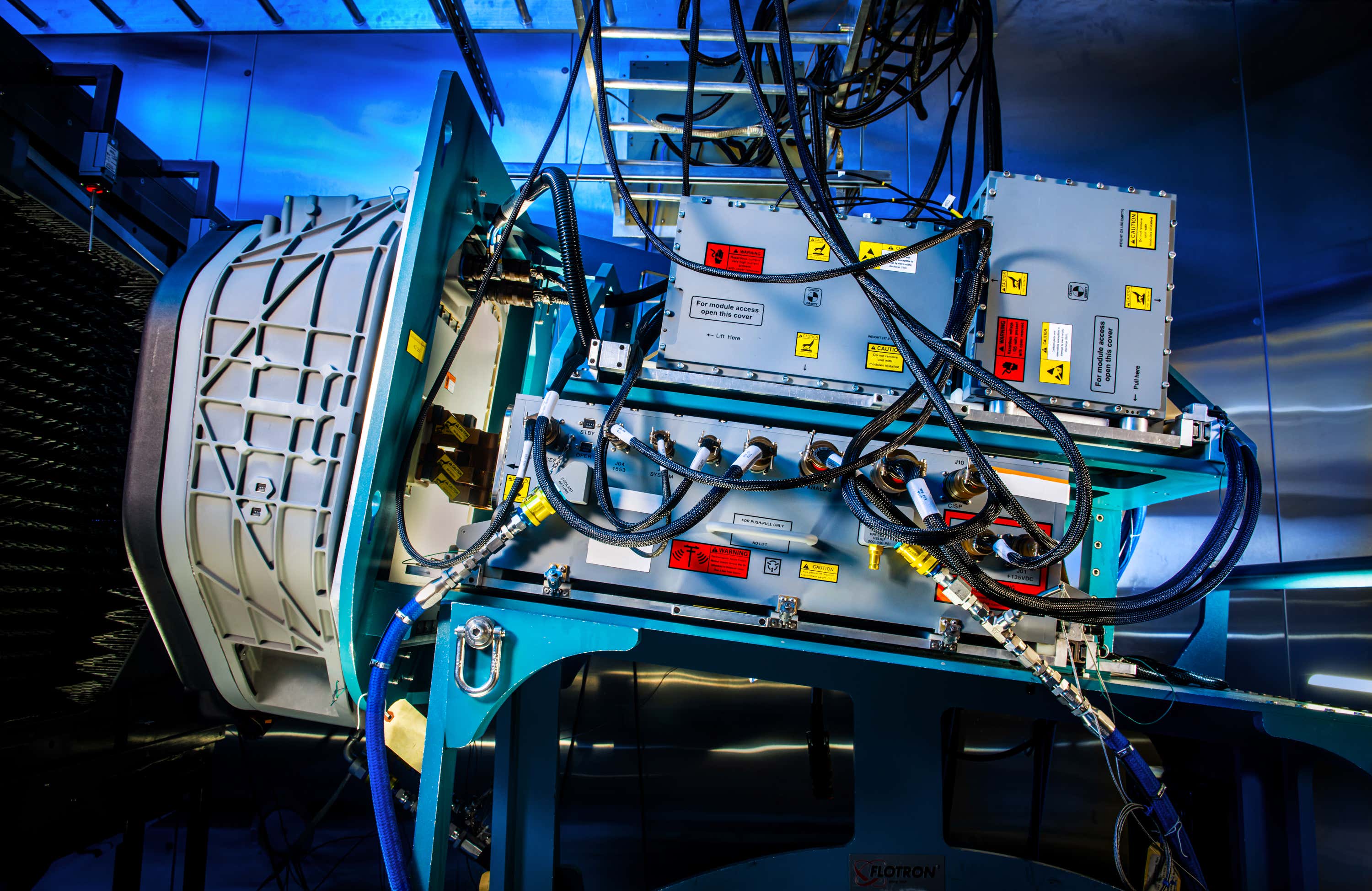
RAYTHEON
The AN/APG-82 AESA on a test stand.
Tyler: What is the APG-82's lineage in relation to other Raytheon products, including outside of the F-15? Where does that lineage come from? And one oddball part of this—how did 'VOODOO1,' your 727 testbed jet, play a role in developing this new radar?
MS: Yeah, what a great question. So what Raytheon is really good at is obviously trying to provide cost-reduction alternatives for customers. What you're getting from the APG-82 is actually born from the APG-79 radar that's on the F-18 and also the legacy APG-63V3 that sits in the F-15C/D aircraft. Essentially, both of those radars came together to create the APG-82. We leveraged all of those different developments in order to get this latest APG-82V1 radar.
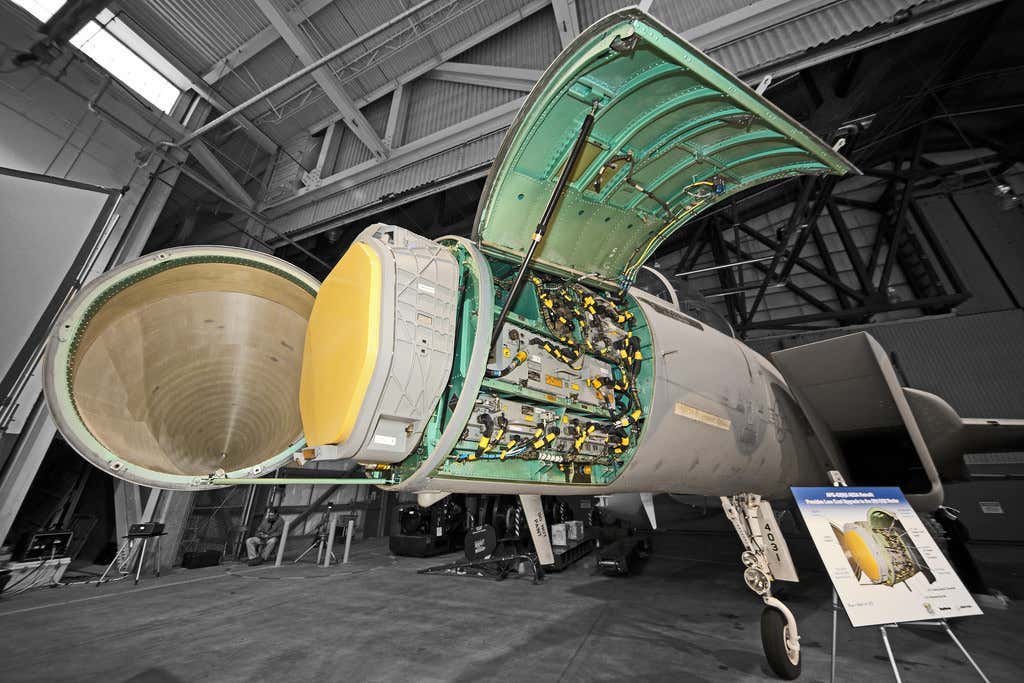
TYLER ROGOWAY/AUTHOR
APG-63V3 installed on one of the F-15Cs of the 142nd FW.
With regards to the [727] aircraft, that's our RMT [Raytheon Multi-program Testbed] platform. That airplane has definitely given us a leg up in terms of testing out the different developments that we do. We use that aircraft to essentially take what we do in our lab and put it into the sky before it gets into a fighter test jet. We can test certain things and work out any bugs that we may see, so it helps with cycle time as far as development is concerned, and we also try to cut costs for our customers by doing so. We have definitely done this on our domestic developments and are doing this on our international developments… It is a really big part of how we cut down development cycle time to get the customer faster technology quicker.
Tyler: Is there an F-15 cockpit in there? How does the 727 act like an F-15?
MS: Yeah, there are different simulators. I don't have the specifics with regards to that, but I do know that we do have different simulators that... What's the word? Well, that simulate... I keep using the word simulator over and over again but it simulates the ADCP II (Advanced Display Processor II) from Boeing, there are simulations on a nav that we would get... and so it's just a giant flying simulator in my mind. But I'm probably not doing it as much justice as I could because that thing has been providing us a significant amount of lift across multiple programs to get things done.
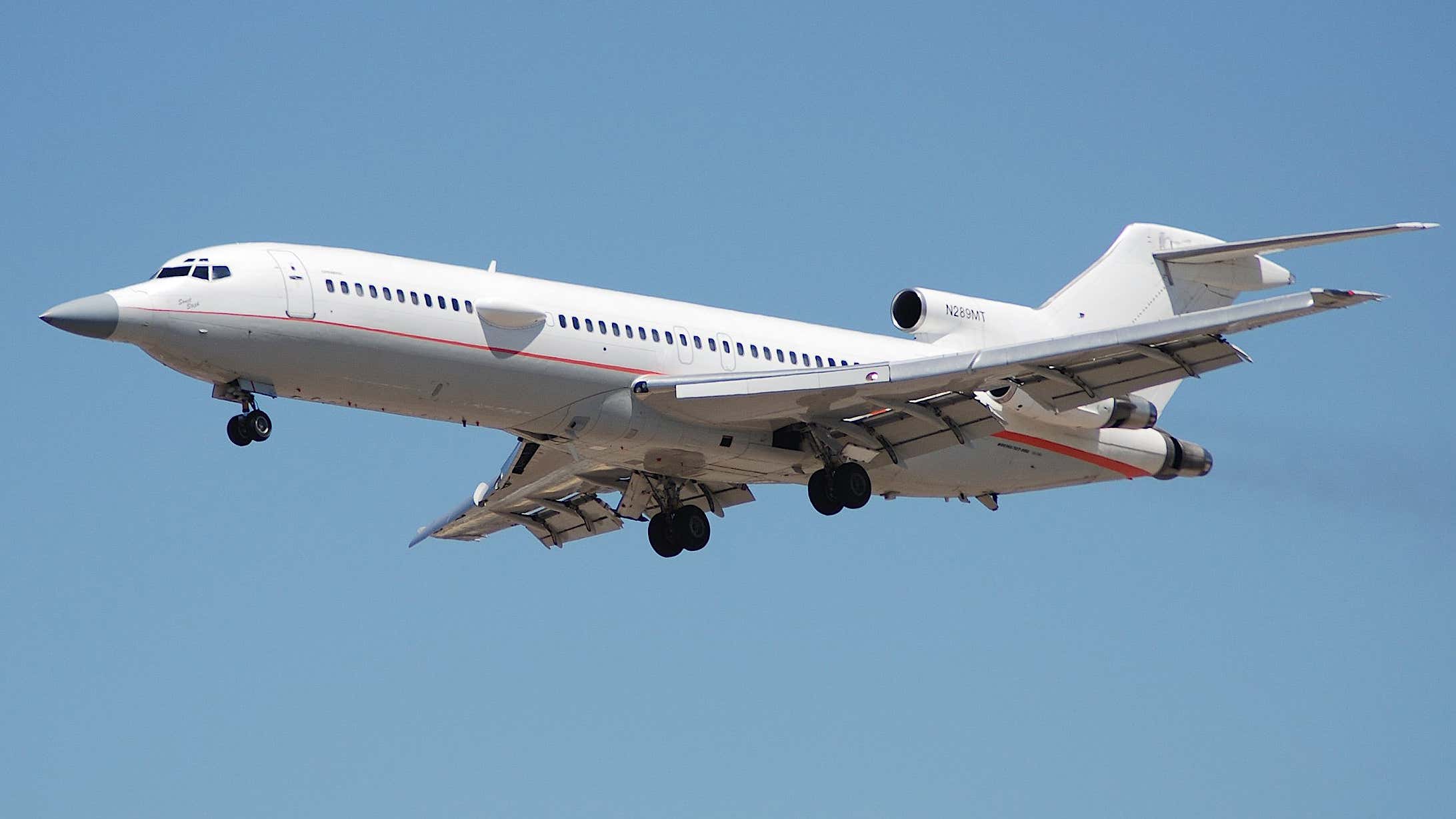
AERO ICARUS/WIKICOMMONS
Raytheon's 727 testbed jet N289MT that goes by the callsign VOODOO1.
Teams are actually looking at capacity across the Raytheon technology portfolio to continue to exploit the legs up that we do get in our development to expand that further in terms of investing for more aircraft… Because that airplane in itself right now has very little capacity with all the work that it's doing... So it's definitely being put to use by our customers.
Tyler: How does the APG-82 differ from the APG-63V3?
MS: The APG-82 was born from the APG-79 and the APG-63. The APG-63V3 is born from the V0 and V1 of that radar, which were the mechanically scanned arrays… The APG-63V3 is an AESA, and it has comparable capability to the APG-82, but at the same time, it really focuses on the air-to-air mission versus both air-to-air and air-to-ground, as we see in the APG-82.
There are some physical differences that go along with the two radars, the -63 has a power supply that is very similar to the APG-82, but then it also has four other units that go along with it. The APG-82 only has two other units that go along with it, and so that really helped also from our maintenance and improved aircraft reliability and availability perspective, which equates to reduced radar sustainment costs. In addition, the APG-82 is a four-channel radar and it has the ability to go to six…
Tyler: What does that exactly mean, in terms of the channels?
MS: Yeah, so with regard to the numbers of channels, the APG-63V3 has a two-channel system with no growth potential because of how long ago it was built. So really, the aircrew would see the significance in the channels by the time it takes to detect and display a target and the ability of the radar to deal with radio frequency interference that's common in electronic warfare…
That is really, I think one of the things that sets the APG-82 apart from the APG-63V3, other than the whole air-to-ground capability.
In addition, on the APG-82, it does provides other tactical benefits that I had mentioned earlier, increased number of radar tracks, growth potential with software upgrades and different things like that. So yeah, they're very similar in terms of the antenna and the power supply, they're very close to each other, but there are differences in that back-end processing that gives the APG-82 the leg up.
Tyler: Will there be any components retrofitted from the old F-15C/D jets to the F-15EX, in terms of the radar?
MS: Yeah, with the commonality, with the antenna and the power supply, there are a few options that we're reviewing with the customer in terms of if they want to go down that road, but right now that's really in the very infant stages... In terms of if they're actually going to go pursue that.
Tyler: Right, as supposed to getting an all-brand-new radar off the shelf?
MS: Yeah, exactly.
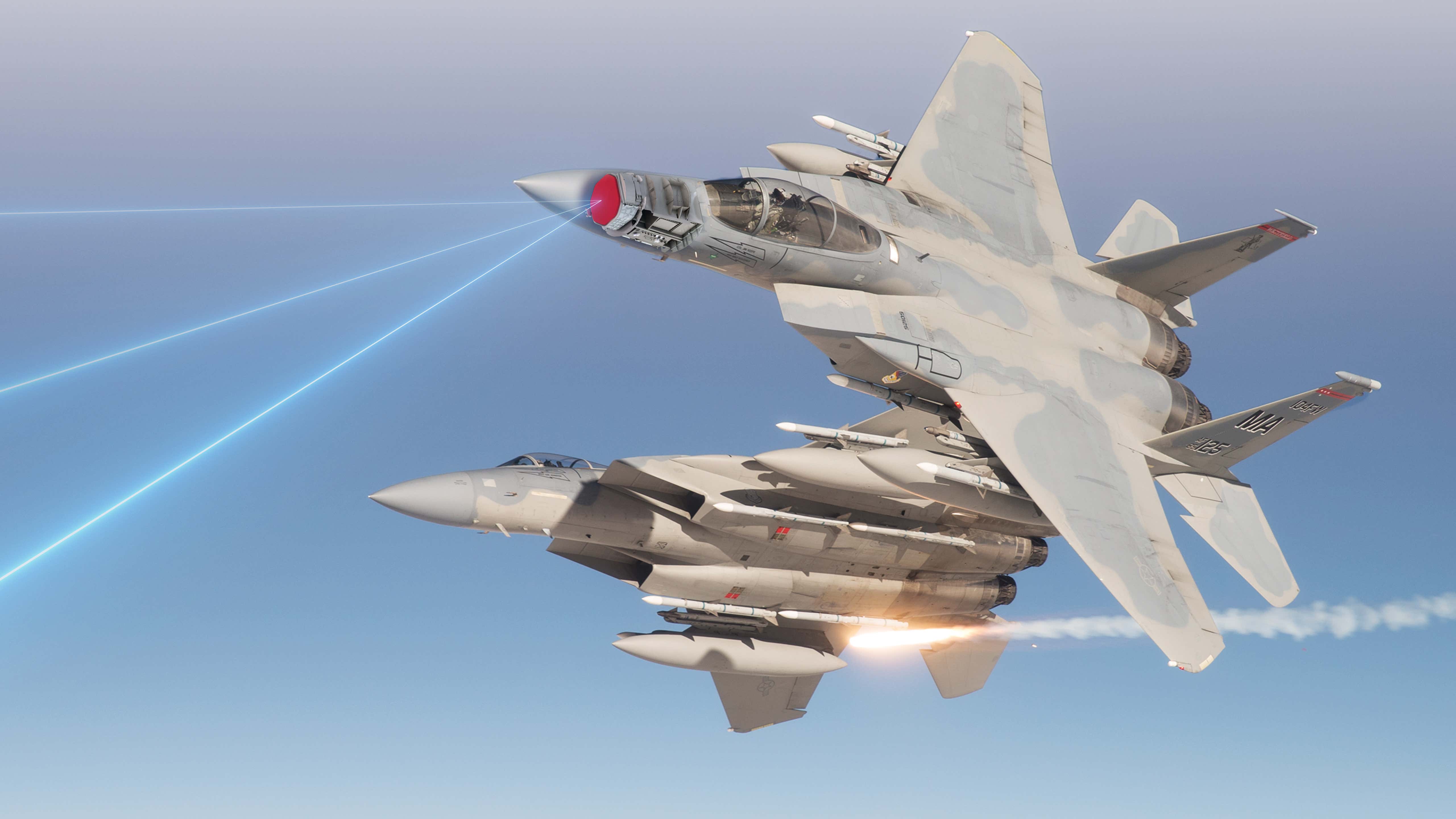
RAYTHEON
F-15Cs shown equipped with AESA.
Tyler: What goes into retrofitting? So if you have this new radar, the APG-82, and it does all these new things, and let's say I'm a foreign customer that has the mechanically scanned array in my Strike Eagle, what goes into retrofitting that into an older jet, or even now, as we're doing it with the USAF’s F-15Es? Is that a pretty complex process or is it sort of a swap-out and swap-in scenario?
MS: Yeah, this is probably a better question for Boeing... But in terms of kits, there are different group kits that we're talking about in terms of group A and group B, that I reference. I think the biggest difference that you may see has to do with the cooling system. The older-vintage radars, I believe were air-cooled, these are liquid-cooled, and so you need to switch out the ECS [Environmental Control System] system in order to do it, which I think is a pretty big change. But again, I would rather defer to Boeing to provide more details on that, just because we provide information that feeds into that, but we are not directly involved with that aspect of it.
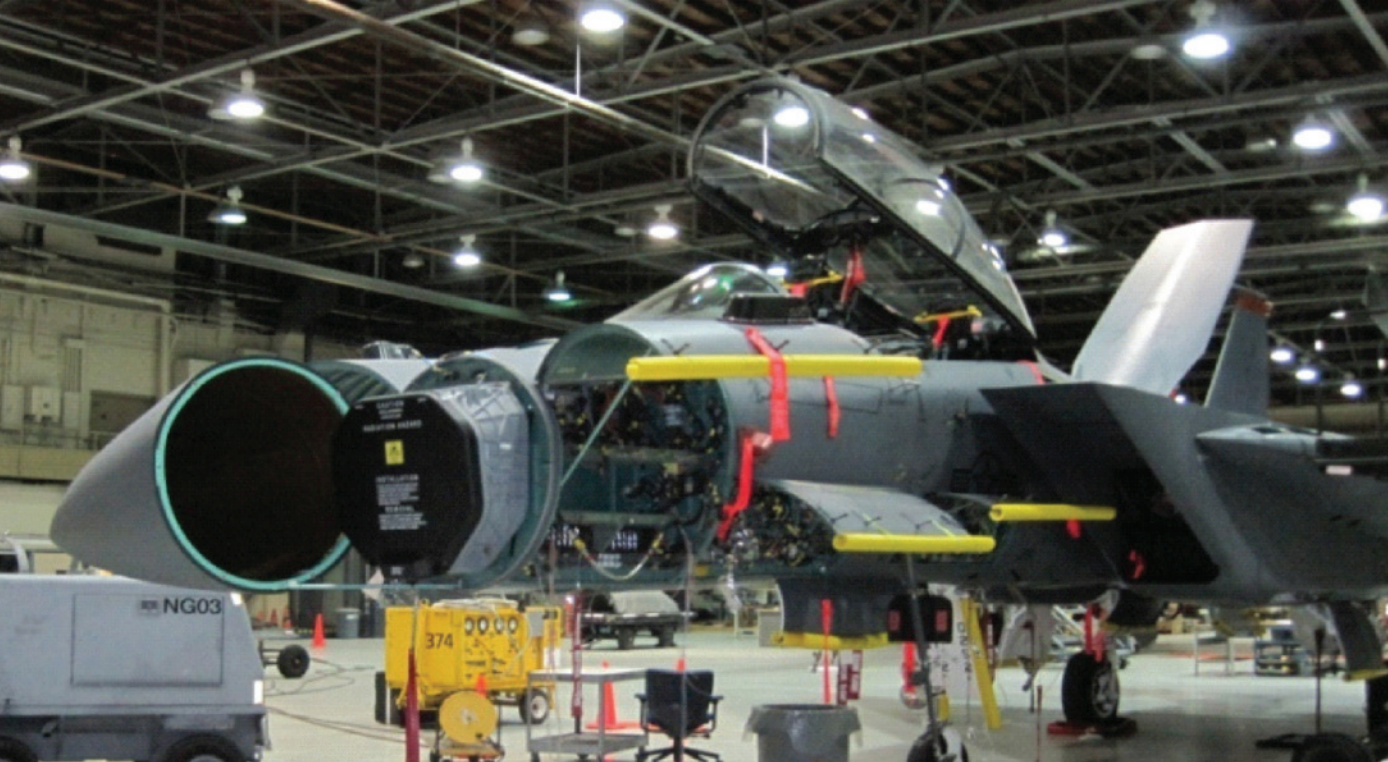
GAO DOCUMENT
The AN/APG-82 being retrofitted into an F-15E Strike Eagle.
Tyler: In the air-to-air realm, we're talking Eagles, the legendary air superiority fighter… What does the APG-82 give the Eagle pilot that the mechanically scanned array doesn't? I know you touched on this a little bit earlier, but can it more easily detect low-RCS [Radar Cross Section] targets, cruise missiles, and all these things that we're hearing about now that are a much bigger threat than maybe they were 10 years ago?
MS: Yeah, so I'm gonna have to be probably really high level on this one.
Tyler: That's fine.
MS: There are a number of advantages with the AESA radar. We have significant capability in beam agility, beam shaping, and overall power. Power is obviously key here. These characteristics allow for significantly greater range in detecting and identifying targets regardless of RCS. The MSA radar is limited by its receiver channels and processing, and then obviously needs to mechanically reposition to see those targets where the AESA antenna does not need to do that.
Tyler: Right, so super-fast scanning and updating, all those types of advantages.
MS: Yes, exactly.
Tyler: The bread and butter for the Strike Eagle is the air-to-ground role… While fighter radars get a lot of talk about air-to-air, the air-to-ground component is key. What is the APG-82 going to bring to the Eagle family when it comes to air-to-ground? Better SAR [Synthetic Aperture Radar imaging] capability? Better detection of moving targets? We obviously have new weapons that can hit those targets, like Storm Breaker. We also have the at-sea side of things. What is it going to bring to the look down to the ground and to the ocean compared to the air side of the mission set?
MS: Yeah, and I think from an air-to-ground perspective, obviously, it has very good performance, but I'm very limited in terms of what we can discuss here. I think it's going to be interesting to see what's going to happen with the capabilities that we can adapt onto the F-15EX. I'm not sure if you're aware but the USAF put out a large-scale RFI [Request For Information] to all of industry last year and solicited additional capabilities that the teams could provide to help enhance the F-15EX aircraft for the future… They received a significant amount of response on that, I think for Raytheon alone, we submitted about 50 ideas.
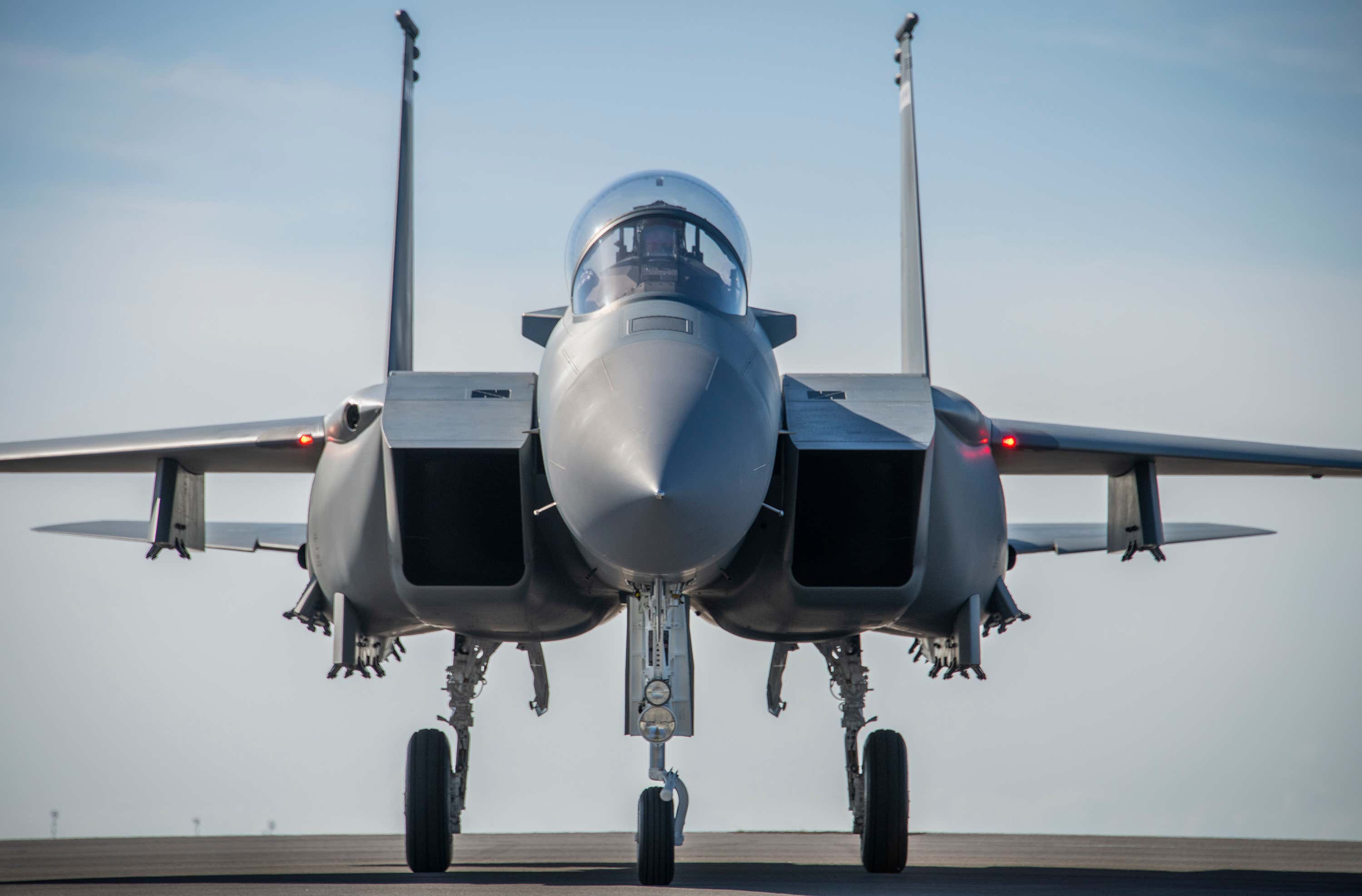
USAF
The first F-15EX arriving at Eglin AFB in Florida.
They're working on down-selecting right now to come up with what the future of F-15EX will look like. So it'll be really interesting to see from a priority standpoint where certain things will fall, and obviously, air-to-ground capabilities are probably going to be a part of that. But I think that is super exciting to just bring up and potentially be a part of in the future, just because obviously the F-15EX has given a good amount of life to the F-15. And what an upgrade could look like with the other sensors that it could be integrated with—definitely will make it unstoppable going into the future.
Tyler: If I'm an F-15EX pilot, from what you understand of the system today, what is it going to look like when it's operational in terms of radar. They have this big display in front of them now. They are going from a little radar scope, that's what, five by five inches or something? And transitioning to this huge wide-area cockpit display. How does this new radar interact with that display? Is the F-15EX’s big cockpit display really needed to get the most out of a radar with this much capability?
MS: From a display perspective, I think obviously, it brings a lot to the table in terms of situational awareness. I think for the APG-82, right now, the display itself would really look similar, but as we continue to add capabilities, obviously there are new items that would be displayed based upon those capabilities. So it will show targets at further ranges, air-to-surface targets will look crisper, allowing aircrew to make better tactical decisions with better tactical decision-making time.
Because of the dynamic resource manager that's within the radar, it helps keep track and display the highest-priority targets so that the aircrew is freed up to complete other cockpit tasks. It looks pretty similar to what we're used to seeing from a display perspective, but things do get added as we continue to proceed down the suite route. But also, at the same time, what's important about the APG-82 is that, when we do get these additional capabilities, there's minimal amount of training that's required for the aircrew, so they can just lock and load and go.
Tyler: “It looks familiar, it feels familiar,” kind of thing, right?
MS: Exactly.
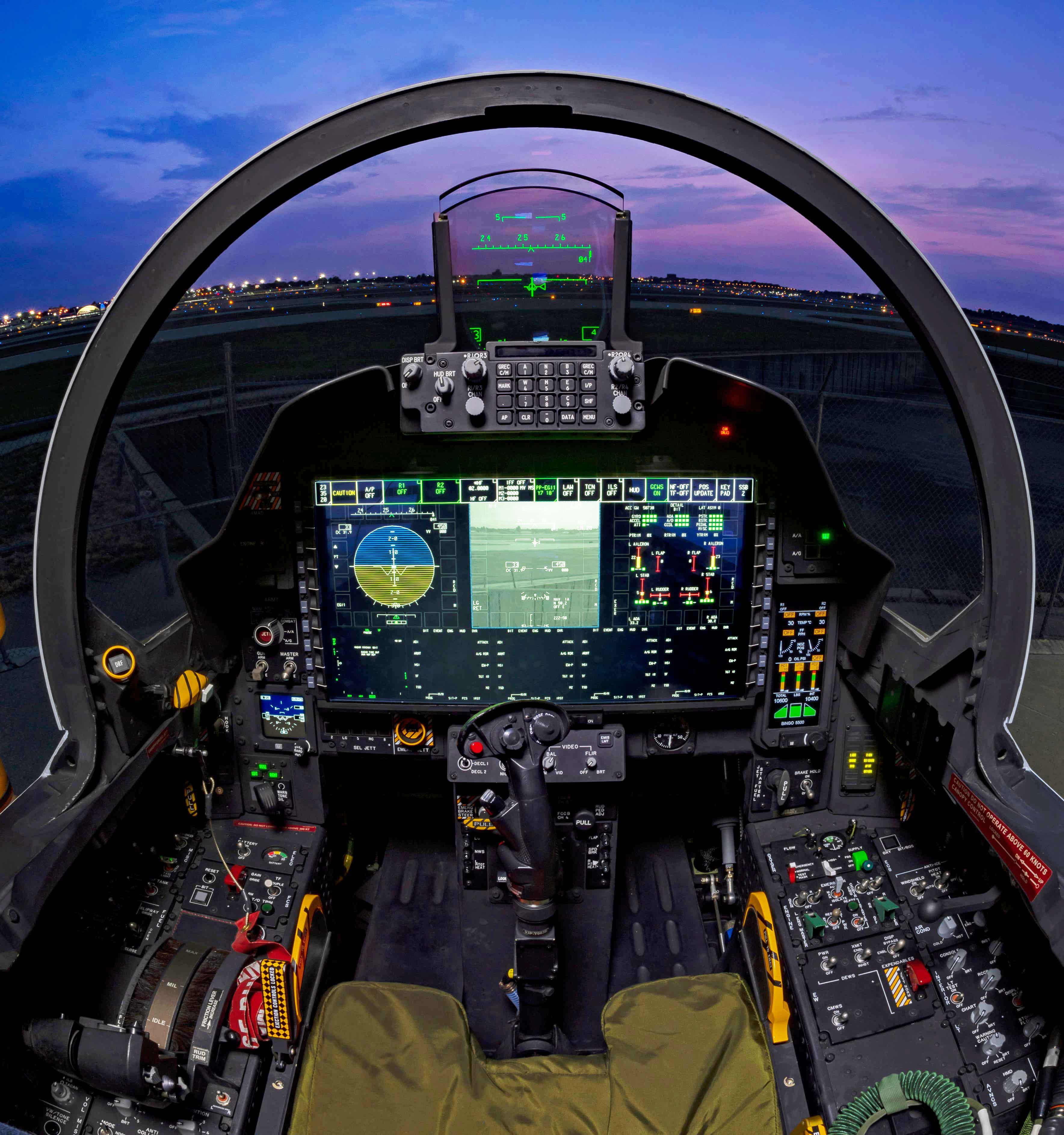
BOEING
The latest cockpit in the F-15 Advanced family, of which the F-15EX is a member. The cockpit is far more advanced than the mix of 'steam' gauges and multifunction displays in the F-15C/D that the F-15EX will replace.
Tyler: You have potentially two people in the cockpit on the EX. On the E you have two for sure. But you have a second seat in the EX as well. Can the new radar do decoupled operations where the front guy or gal is doing air-to-air and the back one is doing air-to-ground with the radar simultaneously?
MS: The radar can only do one thing at a time, A/A or A/G. What you can do is take a SAR map of a ground target and “freeze” it then put the radar back into A/A mode. One person can then designate a target on the frozen SAR picture but the radar isn’t performing any A/G function while that is occurring.
Tyler: Is the APG-82 planned to be integrated with the EPAWSS [Eagle Passive/Active Warning Survivability System], the F-15EX’s advanced electronic warfare suite, which is really the backbone in a certain way of this aircraft, and also will be installed on the F-15E? Is there an integration that's happening just to make them work together?
MS: Yeah, so that's really exciting too, EPAWSS obviously has been quite a big program in the last couple of years, and we have definitely been a part of that, working with both APG-82 and APG-63 and integrating those capabilities together. Right now, they're being integrated to prevent interference and optimize performance on both systems. But in the future, as a reference to that USAF RFI, I think there's also a lot of things that we can do to help communication and get data to other aircraft and other sensors just to have more situational awareness in the battlefield space. So I think there's a lot more potential than we have seen to date on EPAWSS. I'm really excited to see what the future holds for that integration.
Tyler: AESA radar technology is known to have a secondary communications ability. So it'll be able to move lots of data really fast, over long distances, and in a pretty secure manner too? Can you just talk about that?
MS: Yeah, obviously being in the sky, we get a lot of information. Now with the focus towards mission system capability, it'll be really important to tie the radar into that with the information that they get. And so even between aircraft, you can pass information, you have the ability to pass information between the different generations of radars as well. I think we've talked about concepts where we can communicate with F-18, F-16, F-22, F-35, just more information in my mind is always better in terms of where you're at, and we definitely have that ability on the radar. It just matters in terms of where all of that is prioritized in terms of the latest capabilities that the aircrew needs in order to be successful.
Tyler: Just to clarify, the radar itself can be used as an antenna to send that information, correct?
MS: Yes, it can send information as well, that's absolutely right.
Tyler: On the larger picture of F-15EX’s systems, and the E’s too, for that matter, you have a targeting pod. You have an IRST [Infrared Search and Track] pod now that’s about to be fielded, which is really going to be a big deal. You have a whole new digital electronic warfare suite. The EX's even have a missile approach warning system. With this in mind, is the radar also going to integrate with those other systems like the IRST pod? Are they going to be able to work together as a team, where the targeting pod IDs aircraft at long distances or targets on the ground that the radar spots? Can you just speak a little bit about the data fusion that's possible with the radar in the lead here?
MS: Yeah, from a high level, I think that I'm always a believer that anything is possible, and so a lot of these concepts that you're talking about are currently in work and part of these USAF RFI responses that I had mentioned earlier. So what we've been trying to be as the F-15 radar provider, is to be flexible and to just have an open dialogue with our customers to try to let them know what is available, what we can do, and then 'rack and stack' based upon those needs to help bring those capabilities to the field. And so going into this USAF RFI and in the next couple of months where I think they're going to do some major 'rack and stacking' and we'll be able to really see what the priorities are and be able to focus on what the future of F-15EX is going to look like.
Tyler: Just to expand a little bit on that, you have got this F-15 with the most powerful radar on any fighter. And it's going to be able to go out there and see stuff at really long distances, outside the range of the platform its on being engaged. Then we have all these quiet and stealthy aircraft that will be out there as well. Do you see a synergy that's being created with these two generations of fighters? Basically, the F-15EX is being compared to an F-35, but really, from my point of view, they're best working together and F-15EX gives them an ability to have that big searchlight out there via its powerful radar. Is that the sort of stuff you're talking about with the Air Force as far as advantages of the radar system in the F-15EX?
MS: Yeah, what the Air Force has been doing, it seems in the last couple of years, and what we've been focusing on also, is operational analysis, obviously simulation of the battlefield and what things look like and how each one of the sensors can help each other out. And so I think those are definitely things that have been discussed, but those are things that still need to be worked out in terms of how we would go do that and what the mission would look like going into the future.
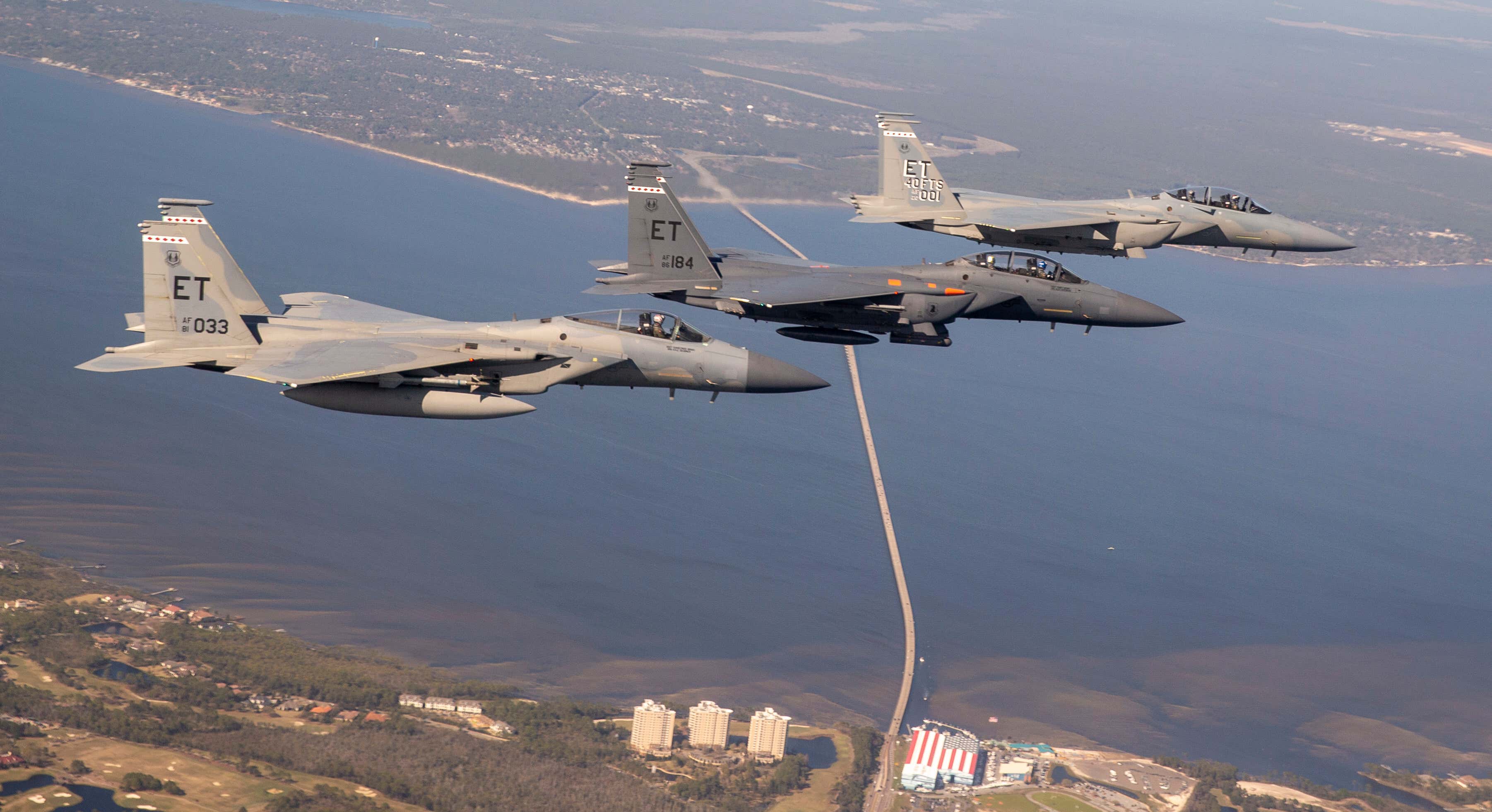
USAF
The full Eagle family currently in the ranks of the USAF: F-15C, F-15E, and F-15EX.
TR: Being around the program for almost two decades, the F-15 radar program, where do you see the system in like 10 or 20 years? Where could this go? Where is the blue sky?
MS: I think the future of APG-82 is bright, there are many different things that we can do from a radar perspective in terms of upgrading the radar that we are looking into, in terms of obsolescence updates that we may need to make, or capability updates that we need to bring to fight the threats that are out there. In addition to that, there's fusion, data fusion that we can do, there are mission systems that we can also adapt into. I mean I think in every corner that you look, it helps us position us to bring the whole suite of air dominance to F-15… To be on the forefront of that and look out at that, it obviously makes me really proud to have been on the program for the last two decades. But it makes me even more excited to help shape what that future may look like, and we have a really great relationship with Boeing, we have a really great relationship with USAF, and we're really looking forward to continuing that relationship with them. And also, from an international perspective, as I keep hitting on, the opportunities seem great there, and so it's going to be really exciting to bring this to our international allies, as well, in the coming years.
Tyler: These radars have a latent electronic warfare capability, is that just one general capability you're looking into leveraging?
MS: I don't know how much I can say there. But there are in my mind, there's just many different ways to slice the onion in terms of... It really goes down to what is USAF going to highly prioritize and what is Raytheon Intelligence and Space going to be in a position to provide them in terms of what that future looks like? I mean, to me there's really nothing that can stop us, it is just how do those needs stack up with the time required to go get those things done, and some of those things. Because obviously, if a difficult algorithm needs to be developed and needs a lot of testing, and we need something very quickly, that's going to take time and money to go get that done. We can definitely do that, it's just is it highly prioritized on the list and is that really what the pilots need? And I think that's what they continually struggle with in terms of getting new capability out to the field and being the most prepared if you were to have to use those capabilities.
Tyler: I think the aircraft is going to have a 20,000-hour service life, so you're going to have decades more I think to figure that out, which is the good news there. Is there anything else you would like to add that we didn’t cover?
MS: I know we focused a lot on the domestic side, I did want to bring up international, I'm sure you know that one of the programs that we have upcoming here is our relationship in Japan. The F-15 radar program has over 60 years of experience working very closely with our Japanese partners, and APG-82 is the next instantiation of that. And so we are very much looking forward to that partnership with Japan to get them the most powerful AESA as well. So I think that would probably be the only thing else that I would add just because that's on the horizon now, and that's really exciting as well.
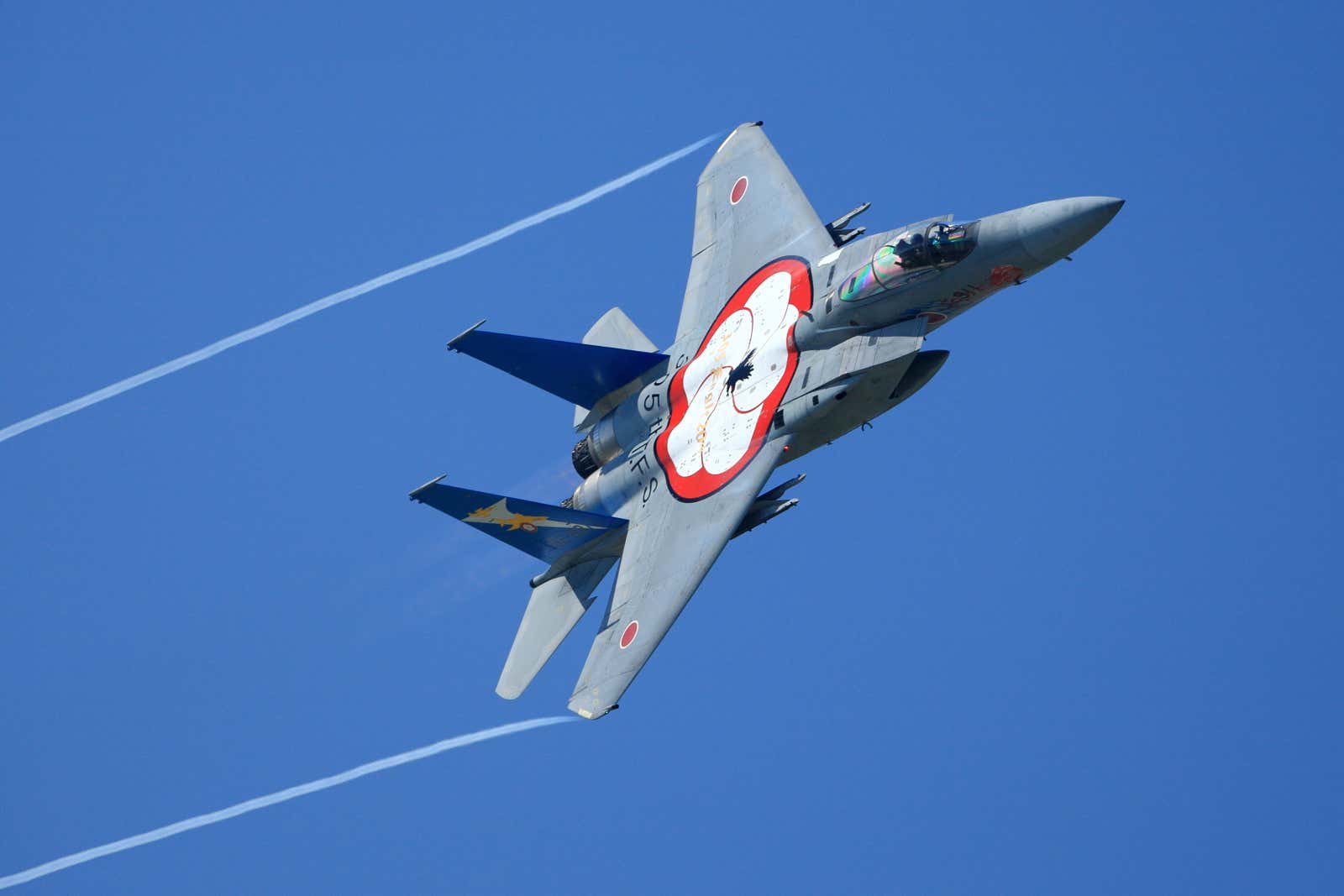
CP9ASNGF/WIKICOMMONS
F-15J wearing one of the amazing paint jobs some of the Japanese Eagles get.
Tyler: We did a piece on that, on their upgrade initiative for some of their F-15s. So that would be going into their J/DJ aircraft, correct?
MS: I believe so… Their existing aircraft that they have right now, yeah.
Tyler: Right. That would definitely fit with what they're looking for, from what we've seen too. So, any talk of Israel wanting in on the APG-82 action? They always seem to be interested in something new, and they modify their F-15s greatly. Have you been in contact with them about upgrading their aircraft?
MS: I know that there's been interest, but I think from a high level, we're still working that out. That's probably further on the horizon.
Contact the editor: [email protected]

We Talk F-15EX’s New Radar With The Woman Who Runs The Program Behind It
The most capable F-15 Eagle ever built also sports what is arguably the world's most powerful fighter radar.

